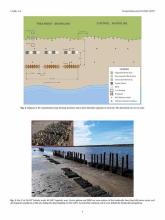
Abstract
Interest and investment in constructing living shorelines rather than harder engineering structures are on the rise worldwide. However, the performance of these interventions in rejuvenating coastal habitats, depositing fine sediments with elevated organic content, and reducing erosion varies widely and is often low along energetic shorelines. In this study, we test the efficacy of a living shoreline design that couples breakwalls and oyster restoration structures, in protecting coastal estuarine ecosystems and their services along energetic shorelines. A field experiment was conducted between 2015 and 2019 along a section of the Atlantic Intracoastal Waterway in northeast Florida, which experiences commercial and recreational vessel traffic. We discovered that organic matter, silt and clay content all increased in sediments collected in the living shorelines compared to paired control treatments. In addition, oysters established and developed into robust reefs on the gabions - wire cages filled with seasoned oyster shells - that were used to facilitate oyster recovery within this living shorelines design, although oyster growth was highest where the gabions were placed at lower intertidal elevations. Additionally, salt marsh cordgrass along shoreline margins protected by the living shoreline structures remained stable or began advancing toward the Intracoastal Waterway channel at rates of ~1 m per year, whereas cordgrass in control treatments retreated at rates approaching 2 m per year. This study provides powerful evidence that vessel wake stress is indeed driving ecosystem loss and that simple nature-based living shoreline structures designed to dissipate this energy can slow or reverse ecosystem decline. More research is needed to optimize these nature-based solutions for shoreline protection in coastal and estuarine settings, and to improve their durability.
About this resource
This article, published in Ecological Engineering, summarizes findings from a project that installed a series of experimental living shorelines at GTM Reserve in Florida. The installations were found to protect marshes, even on shorelines subjected to high energy boat wakes. The article is available from the Ecological Engineering journal or a PDF copy can be requested by emailing: Nikki.Dix@dep.state.fl.us.
Safaka, I, P.L. Norby, N. Dix, R.E. Grizzle, M. Southwell, J.J. Veenstra, A. Acevedo,T. Cooper-Kolb, L. Massey, A. Sheremet, C. Angelini. 2020. Coupling breakwalls with oyster restoration structures enhances living shoreline performance along energetic shorelines. Ecological Engineering 158:106071. Available at: https://doi.org/10.1016/j.ecoleng.2020.106071